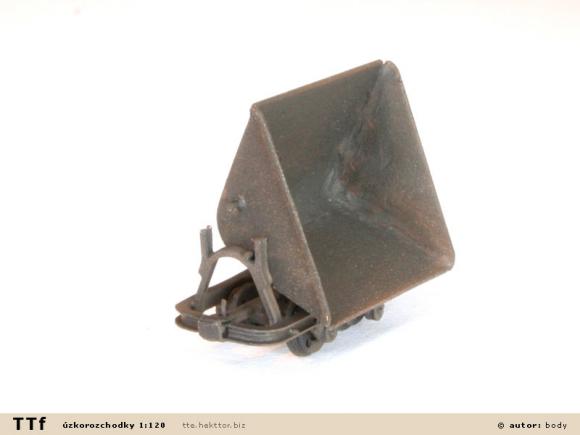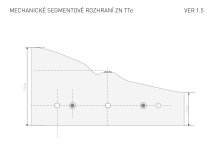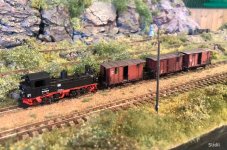Toni
Foriker
Danke, sehr interssante Bilder 

Follow along with the video below to see how to install our site as a web app on your home screen.
Anmerkung: This feature may not be available in some browsers.


Verstehe deine Frage nicht. Und was hast du vor?Reicht der Abstand aus, wenn ein Modul 3- oder 4-Schienengleis (für TTm sollte daher nicht auch der TTe-Abstand gewählt werden) mit beiden Bohrungen versehen wird, um flexibel auf den TT- oder das TTe-Übergang zu reagieren?
Das geht aber nur, wenn die Löcher sich auf die jeweilige Gleismitte und SOK beziehen UND sich nicht in die Quere kommen.
Sage ich ja, nur wenn sich die Löcher in die Quere kommen, hat man nix gekonnt.Ich denke mal, es ist einfacher, dass derjenige, welcher ein Dreischienengleis verlegt einfach die passenden Löcher extra bohrt.

Der Bau ist in meinem anderen Thema beschrieben.
Hallo,Es gibt ja noch die tschechische "Norm", siehe Post #37 von Murten.
Aber auch ich vermisse weitere Grundformen, ich würde gerne auch meine Anlagenenden gerne normgerecht bauen. Vielleicht bietet sich es mal an einem Modultreffen in TTe teilzunehmen.
Right now we are using different type of norm since version 1.3 which is published here by Murten, because ve add two centereng pins for quicker building of layout. Because in TTe layout need to be built more precise. Our main goal is using same standart - position of holes to rails - for possibility of future cooperation. Im Moment verwenden wir - entgegen der hier von Murten veröffentlichten Version 1.3 - einen anderen Normtyp, weil wir zwei Zentrierstifte für einen schnelleren Aufbau der Module hinzugefügt haben. TTe-Module müssen präziser zusammen gebaut werden. Unser Hauptziel ist die Verwendung des gleichen Standards - der gleiche Lage der Löcher ggü. den Schienen - für die Möglichkeit einer zukünftigen Zusammenarbeit.
https://tte.modulovka.cz/wp-content/uploads/2020/06/norma_rozhrani_TTe.pdf
I am member of czech TTe club ( tte.modulovka.cz – TTe CZECHOSLOVAKIA )

Our gallery is here - TTe Modulovka
Our next meeteing will be at Zákupy (near to Zittau) and we planiing to build there layout around 50m. We are fully DCC, even some IV K from Veit. Unser nächstes Treffen wird in Zákupy (in der Nähe von Zittau) sein und wir planen, dort eine Anlage von etwa 50 m aufzubauen. Wir fahren ausschließlich mit DCC, auch einige IV Ks von Veit.
Zákupy 2023 | Zababov
At the begining we develop first version from standart FKTT to be compatibe, pins is not part of modules and we add it during assebling of layout. So it is not problem don´t use it on connection between these two standarts.The distances between the holes and the rails match the TTe standard of the Friends of TT Modules (FKTT), only the Czech pins have to be removed when connecting.
Abut this is big discussion in our club, because when we meet our standrad gauge colleuges, they use various type of profiles and it´s almost impossible to plan layout with matching all profiles, that´s why we use only flat profile. Our still not written rules say that is possible use slope profile, but you have to start at flat, do some modules with slope profile and at the end you have go back to flat profile.A slope profile is also required for the Saxon railways, because level profiles tend to be the exception when running in river valleys.
At these days we have minimum radius 500mm for state railways. It is limited for smooth operation of "rollwagen", because on smaller radius is hard to use it, coupling kinematic of standart TT causes problems and we have to limit it to maximim one normal gauge vehicle in our train.Also interesting is the associated text for the 1.0 standard. However, the minimum arc radius of 500 mm is a challenge for modules that are also home systems.
Deadline for registraiton of normalgauge modules is unfortinately today.If you know more, please publish your dates here in the forum under "Miscellaneous/Dates/Clubs".
Is the meeting starting on Wednesday, February 22nd, 2023 or November 22nd, 2023?
I read that guests are only possible if you can show a registration and agreement with one of the members of the club. This is important to know. Here are the guest rules.
Abut this is big discussion in our club, because when we meet our standrad gauge colleuges, they use various type of profiles and it´s almost impossible to plan layout with matching all profiles, that´s why we use only flat profile. Our still not written rules say that is possible use slope profile, but you have to start at flat, do some modules with slope profile and at the end you have go back to flat profile.Zudem braucht es für Gebirgs-Schmalspurbahnen zusätzlich ein Hang-Profil, denn ebene Flächen sind bei der Führung in den sächsischen Flusstälern eher die Ausnahme.
A slope profile is also required for the Saxon railways, because level profiles tend to be the exception when running in river valleys.
Darüber wird in unserem Club viel diskutiert, denn wenn wir unsere Kollegen mit Normalspur treffen, verwenden sie verschiedene Profile. Dadurch ist es fast unmöglich, ein Layout mit passenden Profilen zu planen. Deshalb verwenden wir nur Flachprofile.
Unsere noch nicht niedergeschriebene Regeln besagen, dass Hangprofil möglich sind. Die Module müssen aber mit einem flachen Profil beginnen, können dann einige Module mit einem Hangprofil enthalten, um am Ende wieder zu einem flachen Profil zurückzukehren.
We already have non official version of slope profile for discussion, but we still don publish it because of it. But it´snot problem to share it, eventualy adjust it, because in my opinion it´s better to have same norm for especialy for slope profiles. Flat profile is still flat and ditches is not big issue.
Wir haben bereits eine nicht offizielle Version des Hangprofils in Diskussion, wir veröffentlichen es deswegen immer noch nicht. Aber es ist kein Problem, es zu teilen, eventuell anzupassen, denn meiner Meinung nach ist es besser, eine einheitliche Norm auch für das Hangprofil zu haben. Das flache Profil ist immer noch flach und Gräben sind kein großes Problem.
At these days we have minimum radius 500mm for state railways. It is limited for smooth operation of "rollwagen", because on smaller radius is hard to use it, coupling kinematic of standart TT causes problems and we have to limit it to maximim one normal gauge vehicle in our train.Interessant auch der zugehörige Text zum Standard 1.0. Der minimale Bogenradius von 500 mm ist für Module, die gleichzeitig auch Heim-Anlagen sind, eine Herausforderung.
Also interesting is the associated text for the 1.0 standard. However, the minimum arc radius of 500 mm is a challenge for modules that are also home systems.
But we have also beet/forest railway in the begining, with 200 mm width and minimum radius 300 mm. On this railway is operation with "rollwagen" prohibited.
Derzeit haben wir bei Staatsbahnen einen Mindestradius von 500 mm vorgegeben. Die Begrenzung soll einen reibungslosen Betrieb von Rollwagen ermöglichen, auf kleineren Radien sind diese nur schwer verwendbar, die Standard-TT-Kupplungskinematik bereitet Probleme, so dass wir es auf maximal ein Normalspurfahrzeug in unserem Zug beschränken müssten.
Wir haben aber auch Rüben-/Waldbahn am Anfang mit 200 mm Breite und Mindestradius 300 mm. Auf dieser Bahn sind Rollwagen nicht erlaubt.
That´s right, with slope standard you are free to add extra module to this combination, but still it start and end on flat profile.This means that a meeting is easier to plan. There are also options for separating modules with slope profiles from one another and combining them with other slope modules. In the end, the meeting planner has more options instead of fewer.
I would be very interested in your slope profile because then I would use that for the transitions in between too (if I ever get that far). Also by personal message.

In ČSD this system was used with "Rollbock". It was used with special braking wagon equipped with buffers and chain coupler as seen in this picture.Do you assume that the ordinary buffers and chain coupler of the standard gauge wagons is used in the "Rollwagen" (Transporter wagon) / "Rollbock" (transporter trailers) train?

In Czechia, this system was used in Frýdlant and for short period in Osoblaha (from 1940s) also with bar couplers. We use also Rollwagen from Karsei and we know about this possibility.In Saxony, bar couplers are between each Transporter wagons. The standard gauge wagons do not touch each other. With the 4-axis trolleys from Karsei, radii of less than 250 mm are possible without any problems, and even less with the new 6-axis trolleys.
We have minimum 85m in main track in real (700mm in TT), so for our region is R500mm optimal. And we are taking advantage from module, mostly that we don´t have to shortening it, because TTe is small enough, but technically it is not problem.In reality, these radii go down to 50m, even in the main track, sometimes 40m in factory sidings. 50m would be 417mm in TT. With the shortening typical for model railways, this is 300mm and less.
Exactly, our college say: "Tell my any exeptions and I tell you where you can find it."Your norm allows deviations if it corresponds to the reality. That would be the case here. So, saxon modules have to be sorted between yours and the forest railways.
